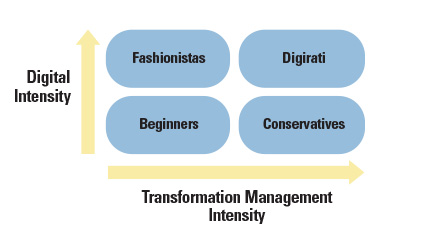In conversations about online marketing, there are often a lot of “you shoulds” and “you musts” that enter the discussion. Yet every recommendation isn’t appropriate for every business. That’s why it’s critical that you test everything to make sure it’s the right fit for your products, audience, and business goals. An operating framework – such as Cialdini’s influence model – can be a great starting point for developing and testing hypotheses. One such framework that offers an important point of reference for organizations developing testing programs is Digital Maturity. Here’s a closer look at the ideas behind Digital Maturity, how it relates to a company’s data culture, and ultimately its impact on your organization’s conversion rate optimization efforts.

Source: Capgemini Consulting
The Concept of Digital Maturity
Digital Maturity was a theory introduced by MIT’s Center for Digital Business, and explored in-depth via a series of publications. This included an article in the MIT Sloan Review, looking specifically at some of the financial advantages of Digital Maturity. Here’s how the study’s authors define the Digital Maturity concept:
“Digital maturity combines two separate but related things. One is digital intensity, the level of investment in technology-enabled initiatives meant to change how the company operates. The other is transformation management intensity, the level of investment in the leadership capabilities needed to create digital transformation within an organization. Transformation intensity consists of the vision to shape a new future, governance and engagement to steer the course and IT/business relationships to implement technology-based change.”
The study itself looked closely at over 400 businesses. They found that while many firms were using technologies like social, mobile, and detailed analytics, that few were capturing true business impacts from the technologies. Said differently, technology was implemented for technology’s sake, but it wasn’t being applied in a way that changed the bottom line in many cases. There are strong parallels between their observations on the broader digital environment, and how many firms approach the topic of conversion optimization.
To help translate their findings, the researchers created a model for companies on the Digital Maturity scale from nascent, entrepreneurial ventures to more highly evolved (and thus profitable) firms.

Image source: MIT Sloan Review
You’ll quickly see that each of the types of firms falls into the low or high category for each factor of digital intensity and transformational intensity, and as a result you get four possible combinations:
- Digital beginners: Low on both aspects, these companies are either unaware of the digital opportunities or simply not investing there. They often do have some more “traditional” technologies on site, such as customer relationship management firms. But there’s significant opportunities for both digital vision development and experimentation with tools.
- Digital fashionistas: These firms are unafraid of experimentation and are quick to hop on the latest trends. They may even be known for cutting edge campaigns. But what these strategies lack is a solid foundation or vision that unites these efforts or translates them into real business benefits that move the enterprise forward.
- Digital conservatives: These companies know the importance of a strong technology vision and believe that it’s critical to their success. They are also highly skeptical of new technologies and not early adopters of trendy products or platforms. These firms can miss important opportunities and typically aren’t seen as innovators. But they can be trusted to develop solid CRO programs, using trusted tools, on initiatives whose value has been proven.
- Digerati: These firms are getting the balance of corporate governance and technological oversight along with experimentation and investments in new technologies right. As a result, technology and a digital presence makes a real and measurable difference in how they do business. CRO is in the bones of how they do business.
Conversion Maturity
There’s a comparable model that could be developed for conversion rate optimization. To acknowledge the limitations of this idea, it’s based on my personal experience with dozens of businesses rather than structured research with hundreds of firms. It would need to be validated to be at the same level as the Digital Maturity scale, but for those who appreciate thought that’s structured this way, the model may be helpful.
I would propose thinking about CRO Maturity on two dimensions:
- Openness to testing: The knowledge that you need to test and willingness to pursue that course of action is one of the dimensions that companies need to be evaluated on. This axis will range from completely unaware of the importance of testing to sophisticated companies that regularly implement structured testing programs tied to their pressing business goals.
- Willingness and ability to apply results: Data and testing are only valuable if they inform business decisions and processes. You need to be able to measure the results of increased conversions and what they mean to your business, or it’s just noise. Companies range from being culturally closed to data and its impact on their business to evolved companies that define, collect, and integrate data points that relate to their most pressing goals.
You can therefore think of your firm in terms of the same grid, one of four “types” in relation to conversion optimization testing:
- Conversion novice: These entrepreneurs or firms aren’t testing. They may be unaware of the importance of CRO, not sure where to start, or simply not investing in this area. Partnering with an expert and beginning to experiment with testing are two ways to improve your performance.
- Data enthusiasts: These companies are very strong on openness to testing and often have more analytical tools tracking every movement and factor associated with their business. But applying that data in a meaningful way becomes the challenge. Data Enthusiasts would benefit immediately from defining their priority objectives, and focusing data on those metrics specifically. From there, it’s important to develop the capabilities of targeted analysis to impact the business’ performance.
- Data conservatives: These companies are strong on business practices and are able to articulate their goals and priorities. They’re willing to consider any tool or input that can give them a leg up over the competition, but it’s critical that you demonstrate the value of a particular approach before they’re on-board. Data conservatives eventually make terrific candidates for developing and integrating ongoing, holistic testing programs into their business processes.
- Datarati: The Datarati have figured out the right balance of testing and strategically defining which goals in their business can be supported by right data. These two work synergistically and the firms capture the value of ever improving sales processes, marketing process, and customer experiences streamlined to make the sale.
Moving Along the Scale
What’s the incentive for working on improving your performance, both in terms of adopting digital solutions and integrating them in meaningful ways into your business? Bluntly, it’s revenues, profits, and customers. As the authors of the MIT study related, “Digirati — those companies that are mature in both dimensions — have the highest performance as a group, far outperforming less-mature firms on multiple financial measures.”
The obvious question for many entrepreneurs and managers is the following: if I recognize myself on the scale, how do I move along? The truth is that companies can develop their expertise in multiple ways. Some start out as digital pioneers, and add corporate vision and governance later. Others have a clear vision of what they want to accomplish, and create the systems to support that later.
For entrepreneurs interested in CRO, I recommend three steps to improve your positioning:
- Define your critical business goals: Be absolutely clear about your company’s strategic and business priorities. If these are clear, choose one high priority area and break down what points could be grounds for improvement. For example, if you need to improve communications with your customers, your e-newsletter could be a terrific place to focus. When you start digging into what areas you need to improve, the list is an easy example of understanding metrics: the number of people seeing the list, who is actually converting, what’s getting them to convert, and so forth.
- Create a targeted testing initiative to support those goals: Using the newsletter example, you might test the packaging. Do the visuals, writing, and topics covered compel your readers and represent your brand? Do your headlines and calls to action grab their attention and force them to buy when you want to sell? Is your value proposition optimized to attract the right person for the audience you’re trying to build?
- Integrate everything: Sit down with your urgent goals in mind, breaking out specific decisions that you need to make that could be impacted by these decisions. Now, consider the decision within the context of the data you’ve collected. What do it tell you and does it help you make better choices?
Where does your company fall on the CRO Maturity spectrum, and what are your next steps to expand your firm’s data capabilities? Let me know in the comments!






